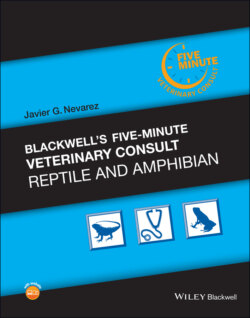Читать книгу Blackwell's Five-Minute Veterinary Consult: Reptile and Amphibian - Javier G. Nevarez - Страница 69
CALCIUM SUPPLEMENTATION
ОглавлениеAll animals need a source of calcium and a calcium to phosphorus ratio of 1.5 : 2. Most invertebrates have a negative calcium to phosphorus ratio, so animals must find other sources of calcium. In their natural environment, these animals will seek out mineral deposits or particular feedstuffs to supplement their calcium intake. In captivity, amphibians do not have the opportunity to seek calcium sources but rather rely on it being supplemented in their diet. Various commercial sources of calcium are available, but some are better than others. First, it is recommended that calcium supplements be purely calcium with no phosphorus or vitamin D3. While many see a benefit of adding a D3 supplement, there are serious and real concerns about oversupplementation of vitamin D3. Adding a calcium supplement that also contains phosphorus does not make sense because the amphibians are already in a negative calcium to phosphorus imbalance. Adding more phosphorus would not help solve this imbalance in an effective manner. The author prefers calcium only supplements including calcium powders sold for reptiles, cuttle bones, and crushed oyster shells. Another alternative is the use of fruit‐flavored calcium carbonate antacid tablets. These tables are more palatable than other products. They can be pulverized or fed in small pieces.
Regardless of the type of supplement, calcium is best offered daily to account for variations in intake. The supplement can be provided by coating prey items. However, it must be noted that when insects are coated with a powdered supplement, it will fall off within 10–20 minutes. Insects should therefore be dusted immediately before feeding. There are some products that advertise calcium in a spray or gel cubes. These have not been proven to be effective and should be avoided until research to support their effectiveness is available. There are also some multivitamin products advertised for reptile and many of these include calcium as well as D3. Given that we do not know the nutritional requirement of most amphibian species, the use of multivitamins is questionable. While it may be beneficial in some species it could be detrimental in others that may be over supplemented by certain minerals or vitamins. Finally, earthworms and hornworms (Manduca spp.) are two excellent sources of nutrition because they tend to have a positive calcium to phosphorus ratio. However this ratio can also vary with the conditions in which they are reared and maintained.
